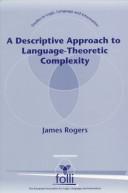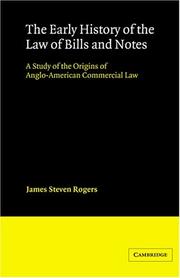| Listing 1 - 10 of 145 | << page >> |
Sort by
|
Book
ISBN: 0706364694 Year: 1986 Publisher: London Lock
Abstract | Keywords | Export | Availability | Bookmark
 Loading...
Loading...Choose an application
- Reference Manager
- EndNote
- RefWorks (Direct export to RefWorks)
Book
ISBN: 0813229197 9780813229195 9780813229188 Year: 2016 Publisher: Washington, District of Columbia : The Catholic University of America Press,
Abstract | Keywords | Export | Availability | Bookmark
 Loading...
Loading...Choose an application
- Reference Manager
- EndNote
- RefWorks (Direct export to RefWorks)
Irish Americans in popular culture. --- Irish Americans --- Autobiography --- Popular culture --- Autobiographies --- Egodocuments --- Memoirs --- Biography as a literary form --- Ethnic identity. --- Irish American authors. --- History and criticism --- Technique

ISBN: 0345338146 9780345338143 Year: 1987 Publisher: New-York: Ballantine,
Abstract | Keywords | Export | Availability | Bookmark
 Loading...
Loading...Choose an application
- Reference Manager
- EndNote
- RefWorks (Direct export to RefWorks)

ISBN: 9781575861364 1575861364 Year: 1998 Publisher: Stanford (Calif.): CSLI,
Abstract | Keywords | Export | Availability | Bookmark
 Loading...
Loading...Choose an application
- Reference Manager
- EndNote
- RefWorks (Direct export to RefWorks)
Book
ISBN: 9781442141803 Year: 2009 Publisher: Rogers
Abstract | Keywords | Export | Availability | Bookmark
 Loading...
Loading...Choose an application
- Reference Manager
- EndNote
- RefWorks (Direct export to RefWorks)
Electronics --- microcontrollers --- 8 bit microprocessoren --- embedded systems --- simulaties
Book
Year: 1867 Publisher: Malines J. Ryckmans-Van Deuren
Abstract | Keywords | Export | Availability | Bookmark
 Loading...
Loading...Choose an application
- Reference Manager
- EndNote
- RefWorks (Direct export to RefWorks)

ISBN: 0521522048 0521442125 0511470592 9780521442121 9780511470592 9780521522045 Year: 1995 Publisher: Cambridge : Cambridge university press,
Abstract | Keywords | Export | Availability | Bookmark
 Loading...
Loading...Choose an application
- Reference Manager
- EndNote
- RefWorks (Direct export to RefWorks)
This study traces the history of the law of bills and notes in England from medieval times to the period in the late eighteenth and early nineteenth centuries when bills played a central role in the domestic and international financial system. It challenges the traditional theory that English commercial law developed by incorporation of the concept of negotiability and other rules from an ancient body of customary law known as the law merchant. Rogers shows that the law of bills was developed within the common law system itself, in response to changing economic and business practices. This account draws on economic and business history to explain how bills were actually used and to examine the relationship between the law of bills and economic and social controversies.
History of the law --- Financial law --- Economic law --- United Kingdom --- Bills of exchange --- 34 <09> <41> --- Rechtsgeschiedenis --(algemeen)--Verenigd Koninkrijk van Groot-Brittannië en Noord-Ierland --- 34 <09> <41> Rechtsgeschiedenis --(algemeen)--Verenigd Koninkrijk van Groot-Brittannië en Noord-Ierland --- -Bills of exchange --- -Negotiable instruments --- -346.0960941 --- Ea1.igbr --- Exchange, Bills of --- Discount houses (Finance) --- Negotiable instruments --- 346.0960941 --- Bills and notes --- Bills of credit --- Commercial paper --- Credit, Bills of --- Credit, Titles of --- Instruments, Negotiable --- Negotiable notes --- Negotiable paper --- Titles of credit --- Choses in action --- Commercial documents --- Commercial law --- Legal instruments --- Drafts --- Financial instruments --- Acceptances --- History --- Law and legislation --- 336.7 <09> --- 336.7 <09> Geschiedenis van het bankwezen --- Geschiedenis van het bankwezen --- History. --- Arts and Humanities --- Negotiable instruments - Great Britain - History. --- Bills of exchange - Great Britain - History.
Book
ISBN: 0199919577 0199910359 9780199919574 Year: 2012 Publisher: New York : Oxford University Press,
Abstract | Keywords | Export | Availability | Bookmark
 Loading...
Loading...Choose an application
- Reference Manager
- EndNote
- RefWorks (Direct export to RefWorks)
James Rogers challenges the basic assumptions of the law of checks and notes and its history, and provides a well-reasoned account of how the law could be changed to better suit the evolution of new payment technologies.
Book
ISBN: 1139094823 1108036562 Year: 1887 Publisher: Place of publication not identified : Cambridge : publisher not identified, Cambridge University Press
Abstract | Keywords | Export | Availability | Bookmark
 Loading...
Loading...Choose an application
- Reference Manager
- EndNote
- RefWorks (Direct export to RefWorks)
Since early times, agriculture has been pivotal to England's economy. This is the sixth in a magisterial seven-volume, eight-piece compilation by the economist James E. Thorold Rogers (1823-90), which represents the most complete record of produce costs in England between the thirteenth and eighteenth centuries. Drawing on a variety of sources including college archives and the Public Record Office, Rogers documents the fluctuating prices of commodities such as livestock, wheat, hay, wool, textiles and labour in a time of great economic change, when the growing economy of the early middle ages was shaken by famine and the Black Death, and then gradually recovered towards the Agrarian Revolution. First published in 1887, Volume 6 presents in tabular form the data from 1583 to 1702, showing the prices of a range of products in towns and cities across the country, which are discussed in essays in Volume 5.
Book
ISBN: 1139094807 1108036546 Year: 2012 Publisher: Cambridge : Cambridge University Press,
Abstract | Keywords | Export | Availability | Bookmark
 Loading...
Loading...Choose an application
- Reference Manager
- EndNote
- RefWorks (Direct export to RefWorks)
Since early times, agriculture has been pivotal to England's economy. This is the fourth in a magisterial seven-volume, eight-piece compilation by the economist James E. Thorold Rogers, which represents the most complete record of produce costs in England between the 13th and 18th centuries. Drawing on a variety of sources including college archives and the Public Record Office, Rogers documents the fluctuating prices of commodities such as livestock, wheat, hay, wool, textiles and labour in a time of great economic change, when the growing economy of the early middle ages was shaken by famine and the Black Death, and then gradually recovered towards the Agrarian Revolution. First published in 1882, this volume discusses the period from 1401 to 1582, using the data published in Volume 3, exploring the distribution of wealth, the cost of foreign produce, weights, measures and currency, and variation in wages.
Agriculture --- Prices --- History. --- England --- Economic conditions --- Commercial products --- Commodity prices --- Justum pretium --- Price theory --- Consumption (Economics) --- Cost --- Costs, Industrial --- Money --- Cost and standard of living --- Supply and demand --- Value --- Wages --- Willingness to pay --- Angleterre --- Anglii︠a︡ --- Inghilterra --- Engeland --- Inglaterra --- Anglija --- England and Wales
| Listing 1 - 10 of 145 | << page >> |
Sort by
|

 Search
Search Feedback
Feedback About UniCat
About UniCat  Help
Help News
News